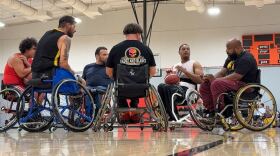A study from Retirement Living took a look at California’s senior populations, home prices and tax rates to help determine the best places to retire.
The city of Oceanside ranked No. 2 because of its senior population and local economy.
"Where Oceanside stood out the most was 1 in 5 residents living in the city are over the age of 65, and that's one of the highest senior populations in the state," said Jailyn Montero, a spokesperson with the research group.
But a high senior population doesn't necessarily mean Oceanside is affordable.
The journal found the median home price in Oceanside was around $850,000, and the median monthly rent was around $2,200.
Montero said the high cost of living comes with a trade-off. "You're paying for coastal living. You're paying for a higher quality of life, a lower poverty rate overall," she said. "Which means ... typically well maintained neighborhoods and public services."
Mary Kelly agreed. She moved to Oceanside in 1994, the year she retired. She participates in programs at the Country Club Senior Center.
"I do tai chi, and when we have little programs sometimes, like drumming ... I love that," Kelly said, noting Oceanside has become more senior-friendly over time.
The city wants to become even friendlier to the aging population.
Oceanside partnered with San Diego State University’s Center for Excellence in Aging & Longevity (CEAL) to develop an age-friendly action plan.
"Every single step of the process is looking at what is already in place in that municipality to help support an age-friendly community, and then getting feedback on where there are gaps," said Jocelyn Protopappas, the special projects manager.
The survey found seniors in Oceanside wanted more communication on resources and information on disaster preparedness.
"Around 50% of residents who completed our survey and attended the listening sessions noted that they didn't know what to prepare in case there was an emergency. They weren't clear on evacuation routes, what they should do with their pets, where should they go," Protopappas said.
As a result, the city already rolled out disaster preparedness courses, even before its action plan has been drafted.
That information came in handy for Mary Kelly during the recent tsunami warning. "The things they told us to do, I actually did," she said. "I went to the bank and got money. I filled my car up with gas, and I threw a blanket in my car, just in case."
Mobility and accessibility are also issues that often keep seniors from attending events like concerts at city parks.
"I think this process of going through and becoming an age-friendly city has really helped us to start to look at things from a different perspective so that we're a more inclusive city," said Manuel Gonzalez, director of Oceanside’s parks and recreation.
He said having a plan in place will help address some of those barriers.
SDSU's CEAL said that by 2030, the San Diego region's population aged 65 and older will double.
"This is having profound impacts on every aspect of our lives, from the education system to our housing environments, to our health care, to our businesses, to our government," Protopappus said. "These age-friendly plans are really critical because this shift in demographics is going to have an impact on everybody."
Oceanside is expected to have an approved age-friendly action plan by the end of this year.





